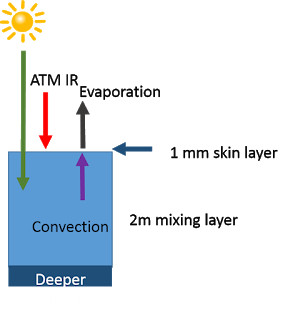
Eli Explains It All: How Back Radiation Warms the Oceans
November 7, 2018
There appears to be a limited but vital audience for this newish series, Eli Explains It All, so once more the Bunny Brings Enlightenment. An everygreen amongst the ignorati is that backradiation can't heat the ocean because it is all absorbed in the first millimeter or less.
And indeed this is true, the distance that IR light radiated from greenhouse molecules penetrates into water is a few wavelengths. That distance is called the skin depth and it is not without consequence in some interesting and amusing ways as St. Jackson has taught us (well some of us).
Yet, as Einstein teaches us, the world is not malicious, but it is subtle, and the reason why heating the surface warms the ocean is closely related to why increasing greenhouse gases warm the Earth.
Eli will now explain. Others have done so, Real Climate for one, but the Bunny has another simple picture that USAns can use on their uncs in a couple of weeks.
Start with the observation that sunlight is absorbed in the first few meters of the oceans. How deep depends, of course, on what other kind of crap is there, bio and anthro, but for arguments sake a few meters. That warms the top few meters, but the surface, that skin layer cools by evaporation. Heat from the mixing layer will move by convection to the cooler skin layer.
Now comes the elegant part, back radiation warms the skin layer. That means back radiation decreases the temperature difference between the skin layer and the mixing layer, Since convection depends on temperature difference, the rate of heat loss from the mixing layer decreases. Thus the mixing layer will be warmer than it would be without back radiation and the extra warmth will be carried into the deeper ocean by conduction and currents.
Greenhouse gas warming of the surface thus acts as a control valve regulating the heating of the oceans by the sun. The same thought about how greenhouse gases regulate the emission of heat from the Earth into space was expressed many years ago by John Tyndall
And indeed this is true, the distance that IR light radiated from greenhouse molecules penetrates into water is a few wavelengths. That distance is called the skin depth and it is not without consequence in some interesting and amusing ways as St. Jackson has taught us (well some of us).
Yet, as Einstein teaches us, the world is not malicious, but it is subtle, and the reason why heating the surface warms the ocean is closely related to why increasing greenhouse gases warm the Earth.
Eli will now explain. Others have done so, Real Climate for one, but the Bunny has another simple picture that USAns can use on their uncs in a couple of weeks.
Start with the observation that sunlight is absorbed in the first few meters of the oceans. How deep depends, of course, on what other kind of crap is there, bio and anthro, but for arguments sake a few meters. That warms the top few meters, but the surface, that skin layer cools by evaporation. Heat from the mixing layer will move by convection to the cooler skin layer.
Now comes the elegant part, back radiation warms the skin layer. That means back radiation decreases the temperature difference between the skin layer and the mixing layer, Since convection depends on temperature difference, the rate of heat loss from the mixing layer decreases. Thus the mixing layer will be warmer than it would be without back radiation and the extra warmth will be carried into the deeper ocean by conduction and currents.
Greenhouse gas warming of the surface thus acts as a control valve regulating the heating of the oceans by the sun. The same thought about how greenhouse gases regulate the emission of heat from the Earth into space was expressed many years ago by John Tyndall
[T]he atmosphere admits of the entrance of the solar heat, but checks its exit; and the result is a tendency to accumulate heat at the surface of the planet.To which Eli would add
The ocean surface admits of the entrance of the solar heat, but infrared surface warming checks its exit; and the result is a tendency to accumulate heat in the oceans.


